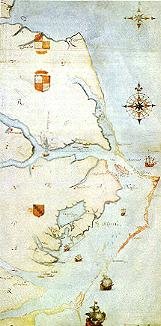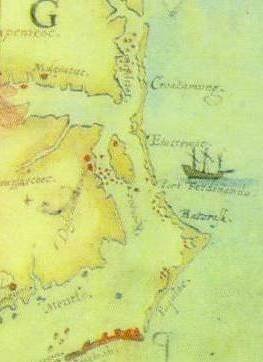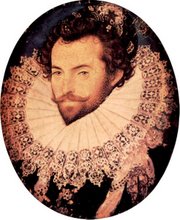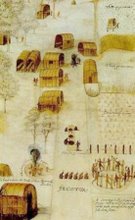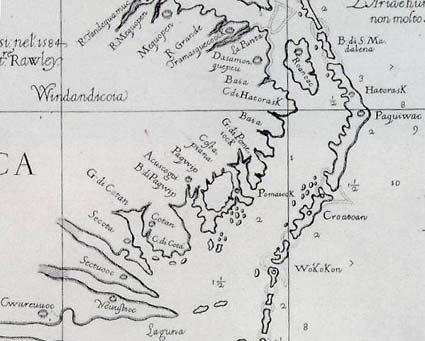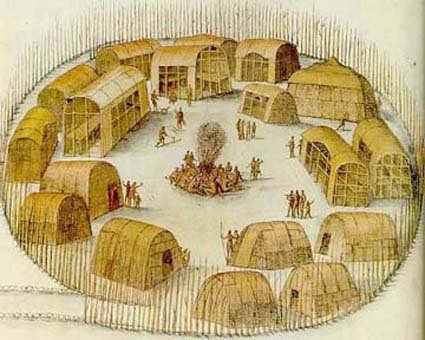If you have yet to read this paper by Roberta Estes, we highly recommend it.
http://www.jogg.info/52/files/Estes1.pdf
This blog is © History Chasers
Click here to view all recent Lost Colony Research Group Blog posts
Saturday, January 15, 2011
Where Have All the Indians Gone? Native American Eastern Seaboard Dispersal Genealogy and DNA in Relation To Sir Walter Raleigh's Lost Colony of Roanoke
Posted by
Historical Melungeons
at
1/15/2011 11:04:00 AM
![]()
Labels: american indian, DNA
Monday, December 20, 2010
Revealing American Indian and Minority Heritage by DNA Testing and Traditional Genealogy
It is an honor to announce the publication at JOGG by Roberta Estes, Administrator of the Lost Colony of Roanoke and the Cumberland Gap DNA Projects along with co-administrator of the Melungeon DNA Project, Hatteras Island, Carolina Native Heritage and several other DNA projects. This is a peer reviewed article which has passed scrutiny by a panel of highly respected DNA experts. This paper is a must read by genealogists who are using any of the various types of DNA testing available. - History Chasers
Roberta Estes's new academic paper has been published as of Sunday. It's free in the Journal of Genetic Genealogy sponsored by ISOGG.
The paper, titled "Revealing American Indian and Minority Heritage using Y-line, Mitochondrial, Autosomal and X Chromosomal Testing Data Combined with Pedigree Analysis" is at the link below:
http://www.jogg.info/62/files/Estes.pdf
The index of the entire journal is available at this link:
http://www.jogg.info/62/index.html
It is a long process to publish a paper at JOGG. Roberta was invited to write this article in March of 2009 and it was submitted a year ago with final revisions in July.
It will also be on her website shortly as well at www.dnaexplain.com under the Publications tab. Lots of free goodies there too.
Abstract:
As a project administrator of several historically based genetic genealogy projects, such as the Lost Colony, Cumberland Gap, Melungeon, Carolina Native Heritage and Hatteras Island projects which involve thousands of participants, I routinely receive questions from individuals who have an oral history of Native American heritage and would like to use genetic genealogical tools to prove, or disprove, their oral history. This paper documents the various discovery steps and processes using different types of DNA testing for a typical individual participant and appropriate family members whocarry an oral Native history combined with genealogical evidence that has been forthcoming during the elapsed years since genetic testing for genealogy first because available. Each test along with associated benefits and detriments are discussed in relation to the analysis of minority ancestry. The conclusion combines the information from all the various tests, pedigree analysis and genealogical evidence, discussing which tests are beneficial and most accurate, and which ones are not useful, and why.
This blog is © History Chasers
Click here to view all recent Lost Colony Research Group Blog posts
Posted by
Historical Melungeons
at
12/20/2010 10:44:00 AM
![]()
Labels: African DNA, american indian, autosomal, European contact, mtDNA, X, Y chromosone
Thursday, January 7, 2010
Cherokee Nation speakers at the Funk Heritage Center in Georgia
This event sounds like a not to be missed event for anyone who can possibly attend.
The following is from an email sent out by Michael Martinez, director of the Reinhardt College Hill Freeman Library and Spruill Learning Center in Waleska, GA. These events are part of the year-long series of events at the college based on the indigenous peoples of North America:
Gene Norris, Robert Lewis, and Gina Burnett will be arriving in Waleska Wednesday evening, Jan. 13 and returning to Oklahoma on Sat the 16th. On Thursday, Jan 14, Mr. Lewis and Ms. Burnett will speak in the library on the third floor at 1 p.m. Mr. Norris will speak that evening at the Funk Heritage Center at 7 p.m. These events are free, open to the public, and no reservations are required. (Also please note that you can become a fan of the Funk Heritage Center on Facebook.)
http://www.facebook.com/#/pages/Waleska-GA/Funk-Heritage-Center/149287297310?ref=search&sid=1033419362.1549261626..1
Funk Heritage Center Gene Norris will speak in the Estelle Bennett Hughes Theater. He is a Board certified genealogist specifically trained in tracing Cherokee ancestry. He is the senior genealogist with the Cherokee National Historical Society, Inc. He is also a member of the Board of Certification for Genealogists in Washington, DC, t...he Cherokee National Historical Society, Inc., the Goingsnake District Heritage Association, the National Genealogical Society, Member of the Board of the Oklahoma Chapter of the National Trail of Tears Association, the Cherokee-Moravian Historical Association and the Carroll County Historical and Genealogical Society, Inc. He has actively been involved in genealogical research for twenty-three years and has been specifically concentrating on Cherokee genealogy since 1994.
More here:
http://trailofthetrail.blogspot.com/2010/01/cherokee-nation-speakers-at-funk.html
© History Chasers
Click here to view all recent Searching for the Lost Colony DNA Blog posts
Posted by
Historical Melungeons
at
1/07/2010 10:26:00 AM
![]()
Labels: american indian, cherokee, funk heritage center, georgia
Saturday, August 23, 2008
Native American Dress
Indian man in his Summer Dress.
The upper part of his Hair is cut short, to make a ridge, which stands up like the Comb of a Cock, the rest is either shorn off, or knotted behind his
Page 4
Ear. On his Head are stuck three Feathers of the Wild Turkey, Pheasant, Hawk, or such like. At his Ear is hung a fine Shell with Pearl Drops. At his Breast is a Tablet or fine Shell, smooth as polish'd Marble, which sometimes also has etched on it, a Star, Half Moon, or other Figure, according to the makers fancy. Upon his Neck, and Wrists, hang Strings of Beads, Peak and Roenoke. His Apron is made of a Deer skin, gashed round the edges, which hang like Tassels or Fringe; at the upper end of the Fringe is an edging of Peak, to make it finer. His Quiver is of a thin Bark; but sometimes they make it of the Skin of a Fox, or young Wolf, with the Head hanging to it, which has a wild sort of Terror in it; and to make it yet more Warlike, they tye it on with the Tail of a Panther, Buffaloe, or such like, letting the end hang down between their Legs. The prickt lines on his Shoulders, Breast and Legs, represent the Figures painted thereon. In his Left Hand he holds a Bow, and in his Right an Arrow. The mark upon his Shoulder blade, is a distinction used by the Indians in Travelling, to shew the Nation they are of. And perhaps is the same with that which Baron Lahontan calls the Arms and Heraldry of the Indians. Thus the several letter'd marks, are used by several other Nations about Virginia, when they make a Journey to their Friends and Allies.
The Landskip is a natural representation of an Indian Field.
Page 5
Tab. 3. Is two Indian Men in their Winter Dress.
Seldom any but the Elder people wore the Winter Cloaks, (which they call Match-coats,) till they got a supply of European goods; and now most have them of one sort or other in the cold Winter Weather. Fig. 1. wears the proper Indian Match-coat, which is made of Skins, drest with the Furr on, sowed together, and worn with the Furr inwards, having the edges also gashed for beauty sake. On his Feet are Moccasins. By him stand some Indian Cabins on the Banks of the River. Fig. 2. wears the Duffield Match-coat bought of the English, on his Head is a Coronet of Peak, on his Legs are Stockings made of Duffields: That is, they take a length to reach from the Ankle to the Knee, so broad as to wrap round the Leg; this they sow together, letting the edges stand out an Inch beyond the Seam. When this is on, they Garter below Knee, and fasten the lower end in the Moccasin.
§. 4. I don't find that the Indians have any other distinction in their dress, or the fashion of their Hair, than only what a greater degree of Riches enables them to make; except it be their Religious persons, who are known by the particular cut of the Hair, and the unusual figure of their Garments; as our Clergy are distinguisht by their Canonical Habit.
The Habit of the Indian Priest, is a Cloak made in the form of a Woman's Petticoat; but instead of tying it about their middle, they fasten the gatherings about their Neck, and tye it upon the Right Shoulder, always keeping one Arm out to use upon occasion. This Cloak hangs even at the bottom,
Page 6
but reaches no lower than the middle of the Thigh; but what is most particular in it, is, that it is constantly made of a skin drest soft, with the Pelt or Furr on the outside, and revers'd; insomuch, that when the Cloak has been a little worn, the hair falls down in flakes, and looks very shagged, and frightful.
The cut of their Hair is likewise peculiar to their Function; for 'tis all shaven close except a thin Crest, like a Cocks-comb which stands bristling up, and runs in a semi-circle from the Forehead up along the Crown to the nape of the Neck: They likewise have a border of Hair over the Forehead, which by its own natural strength, and by the stiffning it receives from Grease and Paint, will stand out like the peak of a Bonnet.

Tab. 4. Is a Priest and a Conjurer in their proper Habits.
The Priest's Habit is sufficiently describ'd above.*
The Conjurer shaves all his Hair off, except the Crest on the Crown, upon his Ear he wears the skin of some dark colour'd Bird; he, as well as the Priest, is commmonly grim'd with Soot or the like; to save his modesty he hangs an Otter-skin at his Girdle, fastning the Tail between his Legs; upon his Thigh bangs his Pocket, which is fastn'd by tucking it under his Girdle, the bottom of this likewise is fring'd with Tassils for ornament sake. In the middle between them is the Huskanawing spoke of §. 32.
The dress of the Woman is little different from that of the Men, except in the tying of their Hair. The Ladies of Distinction wear deep Necklaces, Pendants and Bracelets, made of small Cylinders of the Conque shell, which they call
They are remarkable for having small round Breasts, and so firm, that they are hardly ever observ'd to hang down, even in old Women. They commonly go naked as far as the Navel downward, and upward to the middle of the Thigh, by which means they have the advantage of discovering their fine Limbs, and compleat Shape.

Tab. 5. Is a couple of Young Women.
The first wearing a Coronet, Necklace, and Bracelet of Peak; the second a wreath of Furs on her Head, and her Hair is bound with a Fillet of Peak and Beads. Between the two, is a Woman under a Tree, making a Basket of Silk-Grass, after their own manner.

Tab 6. Is a Woman, and a Boy running after her.
One of her Hands refts in her Necklace of Peak, and the other holds a Gourd, in which they put Water, or other liquid.
The Boy wears a Necklace of Runtees, in his right hand is an Indian Rattle, and in his left a roasting Ear of Corn. Round his Waste is a small string, and another brought cress thro his Crotch, and for decency a soft skin is fastn'd before.
Posted by
Historical Melungeons
at
8/23/2008 12:09:00 PM
![]()
Labels: american indian, john white, Native American, north carolina indians
Monday, August 11, 2008
John White, A Festive Dance
Around AD 1585-93
In 1585, John White and a group of English settlers sponsored by Sir Walter Raleigh arrived on the east coast of North America to found new colonies. White had some artistic training and his duties included making visual records of anything unknown in England, including plants, animals, birds and the inhabitants, especially their costumes, weapons and ceremonies. In the area around Roanoke and the tidewaters of coastal North Carolina they found people who called themselves Secotan, who in mid-July held a green corn or harvest ritual, with ceremonies like the one recorded here. This may be the Green Corn or Harvest Festival, celebrating the first harvest of Indian corn or maize at the end of the summer.
cont. here:
http://www.britishmuseum.org/explore/highlights/highlight_objects/pd/j/john_white,_a_festive_dance.aspx
Posted by
Historical Melungeons
at
8/11/2008 04:01:00 AM
![]()
Labels: american indian, north carolina indians, Roanoke island, secotan, sir walter raleigh
Sunday, May 25, 2008
North Carolina: In the Beginning
Book Review
North Carolina's written history begins in the sixteenth century with the voyages of Sir Walter Raleigh and the founding of the ill-fated Lost Colony on Roanoke Island. But there is a deeper, unwritten past that predates the state's recorded history. The region we now know as North Carolina was settled more than 10,000 years ago, but because early inhabitants left no written record, their story must be painstakingly reconstructed from the fragmentary and fragile archaeological record they left behind.Time before History is the first comprehensive account of the archaeology of North Carolina. Weaving together a wealth of information gleaned from archaeological excavations and surveys carried out across the state—from the mountains to the coast—it presents a fascinating, readable narrative of the state's native past across a vast sweep of time, from the Paleo-Indian period, when the first immigrants to North America crossed a land bridge that spanned the Bering Strait, through the arrival of European traders and settlers in the sixteenth and seventeenth centuries.
Google Books
TIME BEFORE HISTORY by H. Trawick Ward reviews what archaeologists know about the ancient history of native North Carolina from the original settlement of its Appalachian mountain ranges, its Piedmont region, and its coastal provinces some twelve thousand years ago until the encounters between native peoples and European American explorers, traders, soldiers, and settlers from the 1500s through much of the 1700s. The photos of artifacts and scenes from archaeological fieldwork complement well its chapters about native cultures during different periods of the past. Maps and other line drawings are good contributions to the book. Certainly, the book will appeal to archaeologists and historians interested in native peoples of eastern North America. Meanwhile, its lively prose is accessible to any other readers interested in the culture and history of native peoples in North Carolina.
The first chapter outlines the major characteristics of architecture and other artifacts from North Carolina during different periods of the past, as they are currently understood by archaeologists. The authors then trace the history of North Carolina archaeology, from the late 19th century to current problems and prospects for the practice of prehistoric archaeology here at the end of the 20th century.
The second chapter reconstructs the lives of the groups to which archaeologists refer as Paleoindian people, the mobile bands of hunters and gatherers who settled North Carolina between 9500 and 7900 BC, and whose presence here is reflected primarily by certain kinds of stone spearheads. Just when the original North American settlers arrived and what their lives were like are currently very hot topics in archaeology, but it is clear that ten thousand years ago, native North Carolinians were living in colder and drier woodland environments than are here today.
Continued here
Posted by
Historical Melungeons
at
5/25/2008 12:55:00 PM
![]()
Labels: american indian, appalachian, Archeology, Native American, north carolina, paleoindian, piedmont
Saturday, May 17, 2008
Midwest Genealogy Center Now Open for Researchers
Harry Truman's hometown hosts a new site for genealogy buffs
By JUDY WILEY
McClatchy Newspapers
Travelers who've caught the genealogy bug may want to make plans for a trip to Independence, Mo. The new $8 million Midwest Genealogy Center opens May 11 and houses microfilm and microfiche with Civil War histories, American Indian records, black family history records, passenger lists, plantation records and more.
Classes will be offered, as will consultation with foreign-language experts. And if you're really wrapped up in research, there's a break room, lockers and "limited" food service. More: http://www.midwestgenealogycenter.org/
Cont. here:
http://www.miamiherald.com/814/story/528501.html
Midwest Genealogy CenterDiscover YOUR History
The Library's goal in building the Midwest Genealogy Center is to provide a fitting and appropriate facility to house the library's nationally recognized, world-class collection.
The new library will be built on about 8 acres of land at the intersection of Lee's Summit and Kiger Roads in Independence, Missouri, and will open on June 2, 2008.
The new library will cost over $8 million and is being built without an increase in library taxes.
The new library will have over 50,000 square feet of space, on two-levels (more than 4 times larger than the current space).
The new library will have ample tables, computers, and reader-printers for researchers.
The new library will have lockers, a break area, and limited food service for patrons who frequently spend entire days exploring family histories.
The new library will include several oversize parking spaces for people visiting on daytrips, or those passing through with RVs.
The library is accepting donations to make this facility become a reality.
http://www.mcpl.lib.mo.us/genlh/mgc.htm
Posted by
Historical Melungeons
at
5/17/2008 06:58:00 AM
![]()
Labels: american indian, Black History Month, civil war history, Genome research, harry truman, indepence MO, library of congress, midwest genealogy center





